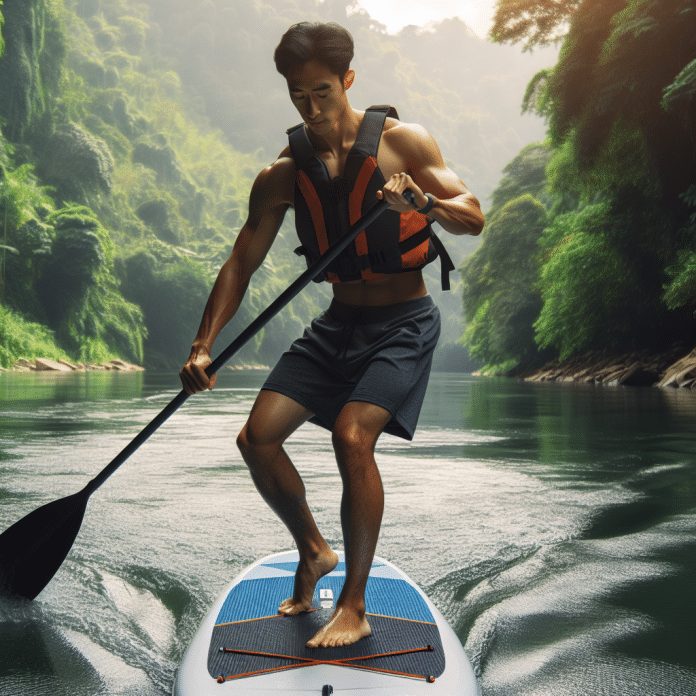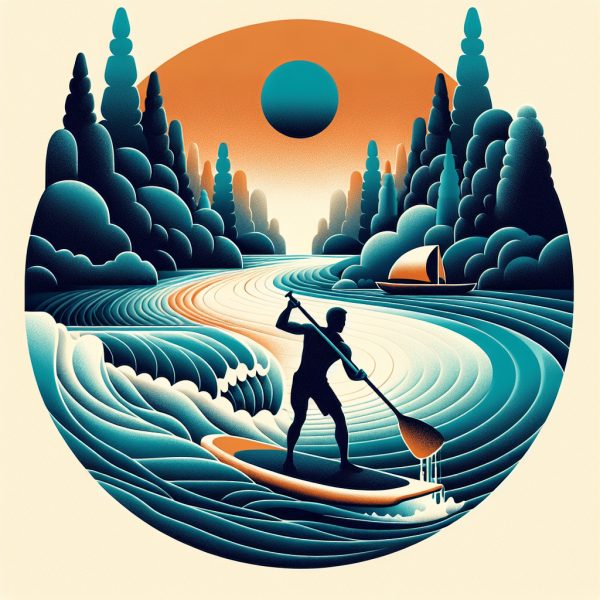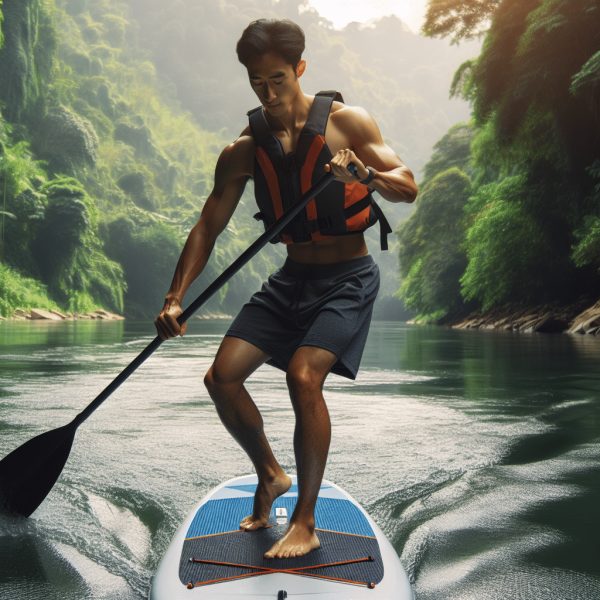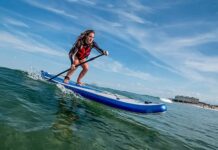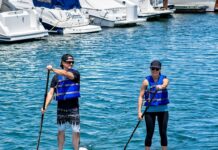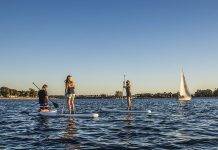With the rising popularity of stand-up paddleboarding (SUP) as a fitness activity, enthusiasts are constantly seeking new places to paddle. While serene lakes and calm coastal waters have been the go-to spots for SUP fitness, an intriguing question arises – can you take your workout to the flowing rivers? It’s time to explore the possibilities and discover the exhilarating experience of SUP fitness paddling on rivers.
SUP Fitness Paddling on Rivers
Exploring the Possibility
Have you ever considered taking your SUP fitness routine to the next level by paddling on rivers? It’s an exciting and challenging way to stay fit while enjoying the beauty of nature. In this article, we will explore the benefits of SUP fitness paddling on rivers, suitable conditions for this activity, essential equipment and gear, safety measures to consider, how to choose the right river, skills and techniques to master, the risks and challenges involved, as well as some recommended river SUP fitness routes. So, grab your paddle and let’s dive in!
Exploring the Possibility
Introduction to Stand-Up Paddle (SUP) Fitness Paddling
Stand-up paddle fitness paddling has gained immense popularity in recent years due to its ability to provide a full-body workout while also offering a peaceful and calming experience on the water. By combining the core-strengthening benefits of stand-up paddling with the cardiovascular intensity of fitness exercises, SUP fitness paddling has become a favorite among fitness enthusiasts. But can we take this exhilarating activity to rivers? Let’s find out!
Advantages of Paddling on Rivers
Paddling on rivers adds a whole new dimension to your SUP fitness routine. The dynamic nature of river currents challenges your balance, strength, and endurance, making it an ideal workout for those looking to take their fitness journey to the next level. Rivers also offer breathtaking surroundings, allowing you to connect with nature and escape the hustle and bustle of everyday life. Moreover, river paddling provides endless opportunities for exploration, making each session a thrilling adventure.
Challenges of River SUP Fitness Paddling
While river SUP fitness paddling offers numerous advantages, it does come with its own set of challenges. Paddling on moving water requires a higher level of skill and technique compared to paddling on still water. Navigating through rapids, obstacles, and changing river conditions demands advanced paddling abilities and confidence. Additionally, river hazards such as strainers and undercut rocks pose potential risks that need to be addressed. With proper preparation and practice, however, these challenges can be overcome, ensuring a safe and enjoyable experience.
Growing Popularity of SUP Fitness Paddling on Rivers
There has been a significant increase in the popularity of SUP fitness paddling on rivers in recent years. This surge can be attributed to a growing interest in outdoor fitness activities, as well as the desire to explore new environments and push personal boundaries. As more people discover the unique blend of physical and mental benefits that river SUP fitness provides, it is no wonder that this exhilarating activity has captivated the hearts of many fitness enthusiasts.
Benefits of SUP Fitness Paddling on Rivers
Full-Body Workout
One of the most significant benefits of SUP fitness paddling on rivers is the ability to enjoy a full-body workout. The constant movement on the water forces you to engage your core muscles to maintain balance, while paddling strengthens your shoulders, arms, and back. The dynamic nature of river paddling also requires leg muscles to constantly adjust and adapt, providing an excellent lower body workout. By engaging multiple muscle groups simultaneously, river SUP fitness paddling ensures an efficient and effective workout.
Improved Cardiovascular Health
Engaging in SUP fitness paddling on rivers elevates your heart rate, promoting cardiovascular fitness. The continuous paddling against the current provides a challenging and intense aerobic workout, strengthening your heart and lungs. The rhythmic motion of paddling also helps improve blood circulation throughout your body, ensuring that oxygen and nutrients reach your muscles efficiently. By incorporating river paddling into your fitness routine, you can enhance your cardiovascular health and endurance.
Enhanced Balance and Core Strength
Paddling on moving water requires constant adjustments to maintain balance. As you navigate through river currents, your core muscles are engaged to stabilize your body and prevent falls. Over time, this constant demand for balance strengthens and tones your core, leading to improved stability and posture. By incorporating river SUP fitness paddling into your routine, you can develop a strong and stable core, benefiting your overall physical performance and reducing the risk of injuries.
Connection with Nature
One of the most remarkable aspects of river SUP fitness paddling is the opportunity to immerse yourself in nature. Rivers often flow through serene and picturesque landscapes, offering a scenic backdrop for your workout. The calming sound of flowing water and the beauty of surrounding flora and fauna create a peaceful and rejuvenating environment. Connecting with nature has been proven to reduce stress, boost mood, and promote overall well-being. By paddling on rivers, you can enjoy the therapeutic benefits of nature while staying active and fit.
Mental Health Benefits
Engaging in SUP fitness paddling on rivers goes beyond physical fitness; it also offers significant mental health benefits. The tranquility and serenity of river paddling provide a much-needed escape from the daily stresses of life. The rhythmic motion of paddling, combined with the calming surroundings, allows you to enter a state of mindfulness and relaxation. River paddling has been shown to reduce anxiety, improve focus and clarity, and promote a sense of peace and well-being. It offers a unique opportunity to rejuvenate both your body and mind.
Suitable Conditions for SUP Fitness Paddling on Rivers
Water Flow and Speed
When considering SUP fitness paddling on rivers, it is crucial to assess the water flow and speed. Rivers vary in their intensity, and it is essential to choose a river with a flow that matches your skill level and fitness goals. Beginners may prefer calmer rivers with a slower flow, while more experienced paddlers can challenge themselves by exploring rivers with stronger currents. It is important to research and understand the flow rates of different rivers before embarking on your SUP fitness journey.
Water Depth and Hazards
Water depth is another vital factor to consider when paddling on rivers. While deeper water offers better buoyancy and reduces the risk of hitting submerged objects, it may pose challenges for beginners who are still developing their balance and paddling skills. It is crucial to choose rivers with a manageable depth based on your experience level. Additionally, understanding and identifying potential hazards, such as rocks, strong eddies, or submerged trees, is essential for safe paddling on rivers.
Weather Conditions
Weather conditions play a significant role in determining the suitability of SUP fitness paddling on rivers. Wind speed, precipitation, and temperature can all affect your paddling experience. Strong winds can create challenging conditions on the water, making it difficult to maintain stability and control. Rainfall can impact water levels and increase the flow rate of rivers, potentially affecting safety. Moreover, extreme temperatures can affect your comfort and well-being. Before heading out to paddle, it is vital to check weather forecasts and plan accordingly.
River Classifications
Rivers are classified based on their difficulty levels, ranging from Class I (easy) to Class V (extremely challenging). It is crucial to choose a river with a suitable classification for your skill and fitness level. Beginner paddlers should start with Class I or II rivers, which offer gentle currents and few obstacles. As your skills progress, you can gradually explore rivers with higher classifications to challenge yourself and improve your abilities. Always remember to prioritize safety and choose rivers that match your experience.
Understanding Rapids on Rivers
Rapids are one of the most exciting aspects of river SUP fitness paddling, but they also require a higher level of skill and experience. Rapids are sections of a river where the water flows faster and forms turbulence, presenting challenges for paddlers. Understanding the different types of rapids, such as riffles, small waves, or larger whitewater sections, is crucial for safe paddling. It is recommended to gain experience and practice paddling on rivers with easier rapids before attempting more challenging ones. Always assess the conditions and your abilities before tackling rapids.
Equipment and Gear for SUP Fitness Paddling on Rivers
Choosing the Right SUP Board
Selecting the right SUP board is essential for an enjoyable and safe river paddling experience. When choosing a board, consider factors such as length, width, thickness, and volume. Longer and narrower boards are more suitable for river paddling as they offer better tracking and maneuverability. Additionally, opt for a board with increased stability to handle the dynamic water conditions. Inflatable SUP boards are popular for river paddling due to their durability and portability. Consult with experts or experienced paddlers to determine the best board for your needs.
Paddle Selection
Choosing the right paddle is equally important as selecting the SUP board. Paddles come in various materials, lengths, and blade shapes. For river paddling, go for a paddle that is lightweight, durable, and adjustable. Adjustable paddles allow you to modify the length based on water conditions and personal preferences. Carbon fiber or fiberglass paddles are commonly used for river SUP fitness, offering a good balance of performance and durability. Test different paddles to find the one that feels comfortable and suits your paddling style.
Leash and Safety Equipment
Using a leash is crucial for safety during river SUP fitness paddling. A leash tethers you to your board, preventing it from drifting away in fast-moving water or during falls. Opt for a waist or coiled leash specifically designed for river paddling, as they reduce the risk of entanglement. Additionally, always wear a personal flotation device (PFD) suitable for paddling. PFDs provide buoyancy and ensure your safety in case of falls or emergencies. Choose a PFD with a snug fit and adjustable straps for maximum comfort and security.
Proper Clothing and Footwear
Proper clothing and footwear are essential for both comfort and safety during river SUP fitness paddling. Wear lightweight, moisture-wicking clothing that allows freedom of movement. Quick-drying materials are recommended, as they help regulate body temperature and prevent discomfort. It is also advisable to wear a hat and sunscreen to protect yourself from the sun’s harmful rays. When it comes to footwear, opt for water shoes or neoprene booties that provide protection and grip on wet surfaces.
Other Essential Gear
In addition to the primary equipment, there are a few other essential gear items to consider for river SUP fitness paddling. First, a dry bag or waterproof storage container is vital to keep your belongings safe and dry, especially if you plan to carry essentials such as your phone, keys, and food. A whistle is also a useful item to have for signaling purposes in case of emergencies. Finally, carrying a river knife or multitool can come in handy for various situations, such as cutting through ropes or gear entanglements. Always pack the necessary gear and be prepared for any unexpected circumstances.
Safety Measures for SUP Fitness Paddling on Rivers
Assessing Personal Skills and Experience
Before embarking on river SUP fitness paddling, it is crucial to assess your personal skills and experience. Paddling on rivers requires a higher level of expertise compared to paddling on still water. Evaluate your paddling abilities, balance, and confidence in dynamic conditions. If you are new to river paddling, consider taking lessons or practicing on calmer rivers first. Gradually build up your skills and experience to ensure a safe and enjoyable experience on more challenging rivers.
Knowing the River Rules and Regulations
Each river has its own set of rules and regulations that paddlers must adhere to for safety and environmental preservation. Familiarize yourself with the specific regulations governing the rivers you plan to explore. These may include speed limits, restricted areas, or specific guidelines for wildlife protection. By following the rules, you not only ensure your own safety but also contribute to the preservation and conservation of these precious natural resources.
Wearing a Personal Flotation Device (PFD)
Wearing a personal flotation device (PFD) is a non-negotiable safety measure for river SUP fitness paddling. PFDs provide buoyancy and ensure your safety in case of falls or emergencies. Choose a PFD specifically designed for paddling, as they offer improved mobility and comfort. It is important to wear a PFD at all times while on the water, regardless of your swimming abilities. Even the strongest swimmers can encounter unexpected challenges, and a PFD can be a lifesaver in such situations.
Understanding River Rescue Techniques
Familiarize yourself with basic river rescue techniques before venturing out for SUP fitness paddling on rivers. Knowing how to perform self-rescue techniques, such as getting back on your board after falling, is crucial. Additionally, learn how to assist others in rescue situations, as it promotes community safety and camaraderie. It is recommended to take a river rescue course or seek guidance from experienced paddlers to learn proper techniques and develop confidence in handling emergency situations.
Paddling with a Buddy
Paddling with a buddy is an excellent safety precaution when enjoying river SUP fitness paddling. Having a paddling partner ensures that someone is there to provide assistance or alert authorities in case of emergencies. It is essential to communicate with your paddling buddy, establish hand signals, and discuss emergency action plans beforehand. By paddling with a buddy, you can enhance safety and make your river paddling experience even more enjoyable.
Building Emergency Action Plans
Preparing emergency action plans is crucial for any SUP fitness paddling adventure on rivers. Discuss and establish emergency procedures with your paddling partner or group, ensuring everyone understands their roles and responsibilities. Identify potential emergency scenarios such as equipment failure, injuries, or sudden changes in weather conditions. Share contact information with your group members, and have a plan in place for contacting authorities in case of emergencies. By being prepared and aware, you can mitigate risks and ensure a safe experience on the river.
Choosing the Right River
Researching River Options
Choosing the right river for SUP fitness paddling is a crucial step in ensuring an enjoyable and safe experience. Researching the available river options in your area or desired paddling destination is essential. Look for rivers that offer suitable conditions based on your skill level and preferences. Seek information on the flow rate, rapids classification, hazards, and local regulations of each river. Online resources, guidebooks, local paddling clubs, and experienced paddlers can provide valuable insights to help you make an informed decision.
Considerations for Beginner Paddlers
If you are new to river SUP fitness paddling, it is recommended to start with rivers that offer beginner-friendly conditions. Look for rivers with slower flows and minimal obstacles. Class I or II rivers are ideal for beginners, as they provide a gentle introduction to moving water while still offering a thrilling experience. These rivers typically have fewer rapids and obstructions, allowing you to focus on developing your skills and gaining confidence.
Intermediate and Advanced River Choices
As your paddling skills progress, you may want to challenge yourself by exploring rivers with intermediate or advanced conditions. Intermediate rivers typically have faster flows and require a higher level of technical paddling. They may feature more significant waves and moderate rapids, providing an opportunity to test your abilities and refine your technique. Advanced rivers present a greater challenge, with stronger currents and more intense rapids. These rivers require advanced skills and experience, and it is essential to approach them with caution and proper training.
Dangers and Risks on Certain Rivers
It is crucial to consider the dangers and risks associated with specific rivers before embarking on your SUP fitness paddling adventure. Some rivers may have hazards such as strong currents, narrow channels, or undercut rocks that pose potential risks. Research and gather information about the potential dangers of the rivers you plan to paddle. Pay attention to warning signs, local knowledge, and safety guidelines. By being aware of the risks, you can make informed decisions and ensure your safety on the water.
Skills and Techniques for River SUP Fitness Paddling
Proper Paddle Strokes
Mastering proper paddle strokes is essential for efficient and effective river SUP fitness paddling. The forward stroke, reverse stroke, and sweep stroke are the primary strokes used on rivers. The forward stroke propels your board forward, while the reverse stroke helps you slow down or stop. The sweep stroke is used for turning and maneuvering. Proper technique, such as using your core muscles and engaging your entire body, will enhance your paddling efficiency and minimize the risk of injury. Practicing and refining these paddle strokes will make navigating the river currents much smoother and more enjoyable.
Navigating Rapids and Obstacles
Navigating rapids and obstacles is a crucial skill for river SUP fitness paddling. Understanding the flow and pattern of rapids, as well as learning how to read the water, will help you choose the best line and approach for optimal navigation. Keep your weight centered and low, and use quick and decisive paddle strokes to maneuver through rapids. When encountering obstacles such as rocks or strainers, learn how to navigate around or over them to ensure a safe passage. With practice and experience, you will develop the ability to navigate rivers confidently and efficiently.
Maintaining Balance on Moving Water
Maintaining balance on moving water is vital for river SUP fitness paddlers. As the river currents push and pull your board, it is crucial to adjust your weight distribution and utilize your core muscles to stay balanced. Keep your feet shoulder-width apart and slightly bend your knees to maintain stability. Engage your core and use quick adjustments to counteract the movements of the water. With practice, you will become more adept at maintaining balance on moving water, allowing you to confidently tackle challenging sections of the river.
Protecting Your Paddle and Board
River paddling can subject your paddle and board to more wear and tear compared to paddling on still water. To protect your equipment, it is essential to develop good paddling habits and techniques. When paddling through shallow areas or over rocks, lift your paddle blade out of the water to avoid hitting the bottom. Additionally, learn how to fall properly to prevent accidental damage to your paddle or board. Developing these habits will help prolong the lifespan of your equipment and save you from unnecessary repairs or replacements.
Developing River-Specific Skills
River SUP fitness paddling requires additional skills compared to paddling on still water. To excel in this dynamic environment, consider developing river-specific skills. These skills may include eddy turns, ferries, or reading water features. Eddy turns allow you to transition from the main flow of the river to a calm spot known as an eddy. Ferries help you cross the river diagonally without being carried downstream by the current. Reading water features involves identifying different currents and understanding how they affect your paddling. By honing these river-specific skills, you will gain confidence and enjoy a more immersive river paddling experience.
Risks and Challenges
Whitewater Hazards
Whitewater hazards are a potential risk when engaging in river SUP fitness paddling. These hazards include large waves, hydraulics, or strong currents that can pose challenges to paddlers. It is crucial to be aware of the specific characteristics of whitewater hazards and understand how they can affect your paddling. Rapidly moving water can push you off balance or cause you to fall, so it is essential to practice self-rescue techniques and acquire the necessary skills to safely navigate these hazards. Always assess the conditions and choose routes that match your skill level and comfort zone.
Changing River Conditions
River conditions can change rapidly due to various factors, including precipitation, dam releases, or changing tides. It is vital to be aware of these changing conditions and their potential impact on your paddling experience. Rising water levels can create faster currents and stronger rapids, while decreasing water levels can expose more rocks or hazards. Always check local river reports, weather forecasts, and any notifications from authorities before heading out to paddle. By staying informed, you can avoid unexpected challenges and make informed decisions on the water.
Strainers and Undercut Rocks
Strainers and undercut rocks are natural hazards commonly found on rivers and can pose significant risks to paddlers. Strainers are obstacles such as fallen trees or branches that allow water to pass through while trapping or pinning objects, including paddlers. Undercut rocks are rocks with openings underneath that can trap and hold watercraft, making it challenging to escape. It is crucial to be vigilant and identify potential strainers and undercut rocks while paddling. Avoid getting too close to or entangled in these hazards, as they can result in dangerous situations. Understanding the river’s characteristics and taking necessary precautions will help ensure a safe and enjoyable experience.
Cold Water Immersion
Cold water immersion is a risk that river SUP fitness paddlers must be prepared for, especially in colder climates or during colder seasons. Falling into cold water can lead to rapid loss of body heat, which can result in hypothermia. It is essential to dress appropriately, wearing proper insulation layers and thermally protective gear to minimize the risk of hypothermia. Be mindful of the water temperature and always check weather conditions before paddling. Additionally, practice self-rescue techniques and know how to perform rescue procedures in case of emergencies involving cold water immersion.
Physically Demanding Nature
River SUP fitness paddling is physically demanding and requires a higher level of fitness compared to paddling on still water. Constant adjustments to balance and paddling against river currents can challenge your endurance and strength. It is crucial to be prepared physically and ensure you have the necessary fitness level to paddle safely on rivers. Incorporate strength and endurance training into your fitness routine to build the necessary muscles and stamina. By being physically prepared, you can minimize the risk of fatigue or injuries and fully enjoy the rewards of river SUP fitness paddling.
Recommended River SUP Fitness Routes
-
Clearwater River, Idaho: This Class II river offers stunning scenery and gentle rapids, making it ideal for beginner and intermediate paddlers. The crystal-clear waters and lush forests create a picturesque backdrop for your SUP fitness workout.
-
French Broad River, North Carolina: With its mix of calm stretches and exciting rapids, the French Broad River provides a variety of options for SUP fitness paddlers. Paddle through the scenic landscape while challenging your skills in the playful rapids.
-
Colorado River, Moab, Utah: Experience the thrill of paddling through red rock canyons and navigating Class II and III rapids on the Colorado River in Moab. This iconic river route offers an exhilarating SUP fitness experience amidst breathtaking natural beauty.
-
Deschutes River, Oregon: The Deschutes River provides a remarkable SUP fitness journey with its diverse landscapes and challenging rapids. Depending on your skill level, you can choose sections that range from calm waters to thrilling Class III rapids.
-
Salmon River, Idaho: For experienced paddlers seeking an adrenaline rush, the Salmon River offers advanced SUP fitness paddling opportunities. Known as “The River of No Return,” it boasts Class III and IV rapids and rewards paddlers with spectacular views of Idaho’s wilderness.
These recommended river SUP fitness routes showcase the variety of experiences waiting to be explored. Remember to research and plan accordingly, ensuring they match your skill level and preferences. Always prioritize safety and enjoy the unique adventure each river has to offer.
Conclusion
Summary of River SUP Fitness Paddling
SUP fitness paddling on rivers adds a new dimension to your fitness routine, providing a challenging and exhilarating workout amidst breathtaking natural scenery. With its full-body benefits, improved cardiovascular health, enhanced balance and core strength, and mental health advantages, river SUP fitness paddling offers an unparalleled fitness experience. By understanding suitable conditions, equipping yourself with the right gear, following safety measures, and honing the necessary skills, you can unlock the potential of river paddling and create memorable adventures.
Encouragement to Explore and Enjoy Rivers Responsibly
As you embark on your river SUP fitness paddling journey, we encourage you to explore and enjoy rivers responsibly. Respect the environment, wildlife, and other river users. Adhere to rules and regulations to preserve these natural wonders for future generations. Continually expand your skills and knowledge, seeking guidance from experienced paddlers and participating in river safety courses. By embracing the beauty of rivers responsibly, you can forge a deep connection with nature while taking your fitness to extraordinary heights.
Benefits of Including SUP Fitness Paddling in a Workout Routine
Including SUP fitness paddling in your workout routine offers numerous benefits that extend beyond physical fitness. It provides an escape from the stresses of everyday life, promotes mental well-being, and fosters a connection with nature. By engaging in a full-body workout that targets multiple muscle groups, you can improve cardiovascular health, enhance balance and core strength, and enjoy the rewards of being in the great outdoors. Whether you choose serene stretches or thrilling rapids, river SUP fitness paddling offers an unparalleled and transformative fitness experience.

